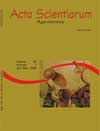<b>Cold storage of oranges cv <em>Navelina</em> with different concentrations of carnauba wax</b> - DOI: 10.4025/actasciagron.v29i1.72
Abstract
Cold storage of oranges cv Navelina with different concentrations of carnauba wax. The aim of this work was to evaluate the effects of different concentrations of carnauba wax and cold storage periods on the preservation of Navelina oranges. After harvest the fruits were pre-cooled at 3ºC for 12 hours and they received the following treatments: T1) fruits without wax (control); T2) carnauba wax at 50% in water; T3) carnauba wax at 100% (without dilution). The fruits were stored for 30, 60 and 90 days under a temperature of 3ºC and 90-95% relative humidity (RH). After the cold storage the fruits were submitted under the temperature of 8±0.5ºC and RH between 75-80%, during four days to simulate the commercialization. The evaluated variables were: weight loss; color; pH; soluble solids (SS); titratable acidity (TA); SS/TA ratio; rottenness; physiological disorders; juice of revenue and sensorial characteristics. The oranges treated with wax without dilution showed higher indication of acquisition. The general quality after 90 days of cold storage was higher in oranges treated with wax. The use of carnauba wax without dilution in oranges Navelina intensifies the brilliancy of the flavedo, reduces the weight loss and the percentage of rottenness and permits the storage for 90 days without compromising the sensorial quality of the fruits.Downloads
Download data is not yet available.
Published
2007-08-20
How to Cite
Malgarim, M. B., Cantillano, R. F. F., & Treptow, R. de O. (2007). <b>Cold storage of oranges cv <em>Navelina</em> with different concentrations of carnauba wax</b> - DOI: 10.4025/actasciagron.v29i1.72. Acta Scientiarum. Agronomy, 29(1), 99-105. https://doi.org/10.4025/actasciagron.v29i1.72
Issue
Section
Crop Production
DECLARATION OF ORIGINALITY AND COPYRIGHTS
I Declare that current article is original and has not been submitted for publication, in part or in whole, to any other national or international journal.
The copyrights belong exclusively to the authors. Published content is licensed under Creative Commons Attribution 4.0 (CC BY 4.0) guidelines, which allows sharing (copy and distribution of the material in any medium or format) and adaptation (remix, transform, and build upon the material) for any purpose, even commercially, under the terms of attribution.
2.0
2019CiteScore
60th percentile
Powered by 

2.0
2019CiteScore
60th percentile
Powered by 



















































